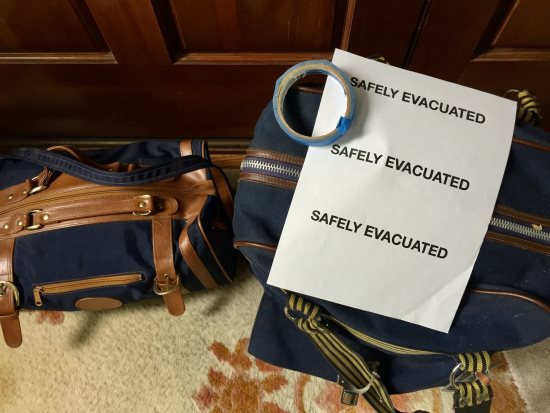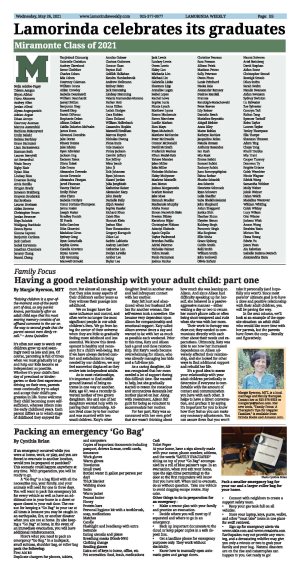| | Published May 26th, 2021
| Packing an emergency 'Go Bag'
| | | By Cynthia Brian |  | | Pack a smaller emergency bag for your car and a larger roller bag for your home. Photo Cynthia Brian |
If an emergency occurred while you were at home, work, or play, and you are forced to evacuate to another location, would you be prepared or panicked? This scenario could happen anywhere at any time. With preparation, you will be ready to go.
 A "Go Bag" is a bag filled with all the necessities you, your family, and your animals will need for one to three days. You will want to pack this emergency kit for every vehicle as well as have an additional one in your home in a closet or space closest to your exit door. The reason for keeping a "Go Bag" in your car at all times is because you may be caught in an earthquake, fire, or another disaster when you are not at home. By also keeping a "Go Bag" at home, in the event of an immediate evacuation, you will have additional reinforcements.
A "Go Bag" is a bag filled with all the necessities you, your family, and your animals will need for one to three days. You will want to pack this emergency kit for every vehicle as well as have an additional one in your home in a closet or space closest to your exit door. The reason for keeping a "Go Bag" in your car at all times is because you may be caught in an earthquake, fire, or another disaster when you are not at home. By also keeping a "Go Bag" at home, in the event of an immediate evacuation, you will have additional reinforcements.
 Here's what you need to pack an emergency "Go Bag." In a backpack, small suitcase, shoulder bag, or roller bag pack the following:
Here's what you need to pack an emergency "Go Bag." In a backpack, small suitcase, shoulder bag, or roller bag pack the following:
 First Aid kit
First Aid kit
 Duplicate chargers for phones, tablets, and computers
Duplicate chargers for phones, tablets, and computers
 Copies of important documents including passport, drivers license, credit cards, insurance
Copies of important documents including passport, drivers license, credit cards, insurance
 Work gloves
Work gloves
 Warm gloves
Warm gloves
 Towelettes
Towelettes
 Small towel
Small towel
 Bottled water (1 gallon per person per day)
Bottled water (1 gallon per person per day)
 Thick blanket
Thick blanket
 Walking shoes
Walking shoes
 Socks
Socks
 Warm jacket
Warm jacket
 Peanut butter
Peanut butter
 Honey
Honey
 Protein bars
Protein bars
 Personal hygiene kit with a toothbrush, soap, medications
Personal hygiene kit with a toothbrush, soap, medications
 Matches
Matches
 Candle
Candle
 Flashlight and headlamp with extra batteries
Flashlight and headlamp with extra batteries
 Eating utensils and plates
Eating utensils and plates
 Breathing masks (Niosh-N95)
Breathing masks (Niosh-N95)
 Clothing change
Clothing change
 Reading glasses
Reading glasses
 Extra set of keys to home, office, etc.
Extra set of keys to home, office, etc.
 Pet necessities: food, leash, medications
Pet necessities: food, leash, medications
 Cash
Cash
 Toilet Paper
Toilet Paper
 At your home, have a sign already made with your name, phone number, address, and the words "SAFELY EVACUATED" sitting on top of your "Go Bag" accompanied by a roll of blue painter's tape. In an evacuation, when you exit your home, tape the sign (time permitting) to the door so the first responders will know that you have left. When told to evacuate, do so without question. Take one vehicle to avoid clogging escape routes. Stay calm.
At your home, have a sign already made with your name, phone number, address, and the words "SAFELY EVACUATED" sitting on top of your "Go Bag" accompanied by a roll of blue painter's tape. In an evacuation, when you exit your home, tape the sign (time permitting) to the door so the first responders will know that you have left. When told to evacuate, do so without question. Take one vehicle to avoid clogging escape routes. Stay calm.
 Other things to do in preparation for an emergency:
Other things to do in preparation for an emergency:
 � Make a rescue plan with your family and practice an evacuation.
� Make a rescue plan with your family and practice an evacuation.
 � Decide where you will meet up if separated and where to go in an emergency.
� Decide where you will meet up if separated and where to go in an emergency.
 � Back up important documents to the cloud or keep paper copies in a safe deposit box.
� Back up important documents to the cloud or keep paper copies in a safe deposit box.
 � Get a landline phone for emergency purposes only. They work without electricity.
� Get a landline phone for emergency purposes only. They work without electricity.
 � Know how to manually open automatic gates and garage doors.
� Know how to manually open automatic gates and garage doors.
 � Connect with neighbors to create a support safety team.
� Connect with neighbors to create a support safety team.
 � Keep your gas tank full on all vehicles.
� Keep your gas tank full on all vehicles.
 � Store your laptop, keys, purse, wallet, and other "must take" items in one place for swift retrieval.
� Store your laptop, keys, purse, wallet, and other "must take" items in one place for swift retrieval.
 � Sign up for emergency alerts via www.nixle.com and www.cwsalerts.com
� Sign up for emergency alerts via www.nixle.com and www.cwsalerts.com
 Earthquakes may not provide any warning, and a devastating wildfire may give you only a minute or two to grab your family and your bag. Natural disasters are on the rise and catastrophes can happen to you. Get ready to go!
Earthquakes may not provide any warning, and a devastating wildfire may give you only a minute or two to grab your family and your bag. Natural disasters are on the rise and catastrophes can happen to you. Get ready to go! |
| | | | | | | | | | | | |



